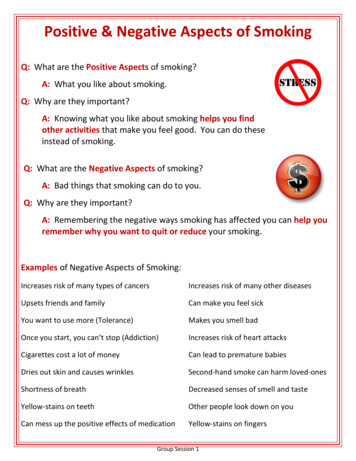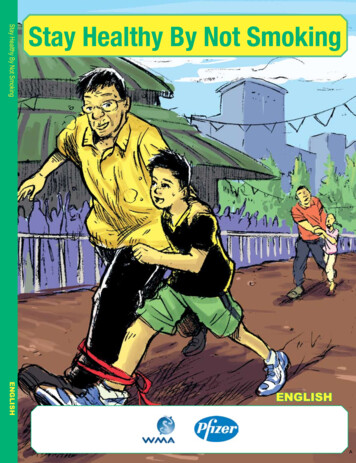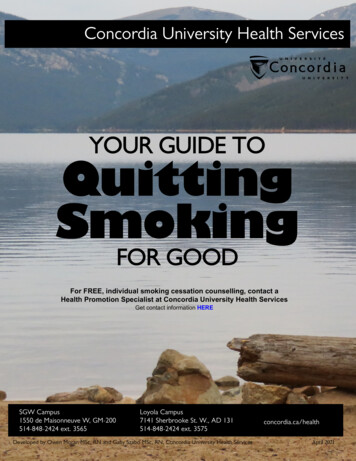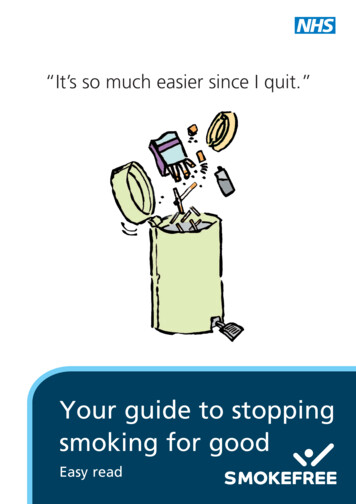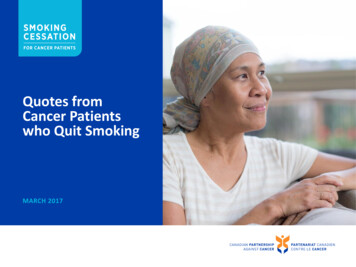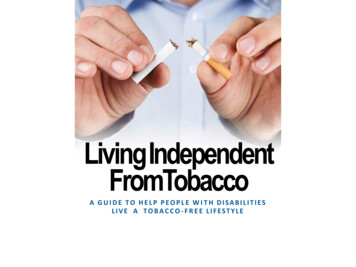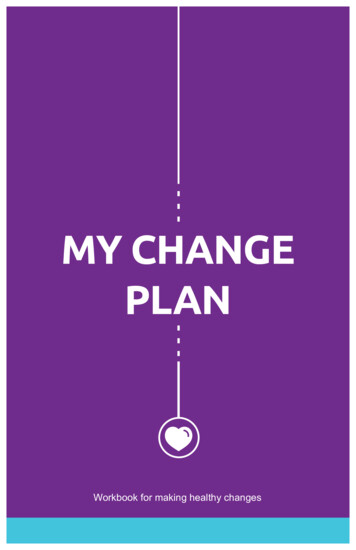
Transcription
otwoHA
Giving up smoking is the bestthing you can do for your health.The good news is you don’t have todo this on your own. There’s lots offree help available (see page 24).This booklet will help you and you’llbe giving yourself the best possiblechance of success if you use ittogether with the free support andstop smoking medication available.To find out more about yourlocal stop smoking services, callSmokeline on 0800 84 84 84 tospeak to an expert or visitwww.nhsinform.scot/smokelineWe are happy to consider requests forother languages or Easy Read. Pleasecontact 0131 314 5300 or B
ContentSTHINK Thinking aboutstopping3PLANPreparing to stop11STOPStopping23COPE Staying stopped45
Thinking2
about stoppingWay to freedomYou can do it!We are ready to help you.If you’ve tried to quit before andnot succeeded, try again whenyou are ready.You will succeed!3
THINKThe key to success is wantingto stop, then preparingthoroughly, so you havethe best chance of success.Stopping smoking will positivelyaffect the rest of your life – it’sworth doing properly!4
Writing it downwill help you thinkabout the reasons youstarted smoking.I started smoking because: A re these reasons still true today? Do you continue to smoke for thesame reasons? The answer is probably ‘no’.5
Think about whyThe following list mayhelp you decide.Tick your reasons .WHYI want to stop because:m I want to improve my health.m I want my children to grow upnon-smokers.m I can’t afford it. It costs too much!m It’s more sociable to be smoke-freethese days.m I want my clothes fresh and freefrom stale smoke.m I don’t like being addicted to smoking – it’s time to stop.m I want a smoke-free home for myfamily, friends and pets.6
you want to stop. and add your own.On a bad day, you can remindyourself why you’re quitting.I want to stop because:Rewards7
Why it’ S worthStoppingDid you know that within:Days: pulse/heart rate drops carbon monoxide and oxygen levelsin blood return to normal senses of taste and smell sharpenWeeks: coughing and shortnessof breath decreaseslung function improvesthe risk of a heart attackbegins to reduce the risk of post-operativecomplications is reduced there is a reduced risk ofrespiratory infections skin looks healthier8
Months: symptoms of chronic bronchitisimproveulcer risk dropsOne year: there is a reduced risk of heartor respiratory diseaseFive years: the risk of heart disease, or ofanother heart attack or of cardiacdeath among those already withheart disease, falls considerablyBeyond five years/longer term: the risk of lung cancer, other cancersand stroke falls considerably the risk of death from chronicobstructive pulmonary disorder(COPD) is reduced.9
Preparing10
to stopPlan aheadTo succeed in stoppingsmoking, it’s best if youdo some preparation first.11
PLANThink about who can help youwhen you stop smoking . yourpartner, family, friends?What can they do to help you?12
Decide the dayyou are stopping.Well done!You’re onyour way tostoppingGive yourself a couple ofweeks to prepare. This willgive you enough time toget yourself ready. Writeyour chosen date 28293031I am stopping on:Quit date13
Think about the things thatyou associate with smoking.These may include:When youhave a cup oftea or coffeeAfter yourdinner in theeveningSocialoccasions When you’refeeling stressedor bored14First thing inthe morning
You may want to write your ownlist of the things or situations thatyou associate with smoking.15
SolutionS . . .Now write some solutions thatyou can think of which may makethese things easier to cope with.These may include:onot to ggninnaPlutdoorto the o reaasmoking ialisingcwhile soChanginroutine g yourmorning in theDecbuy idingciga notret totes16
My solutions are:There are a number of solutions thatcan help you stop smoking and staystopped. Smoking is strongly linkedto certain times and situations –some simple stress reducers areon page 47.17
.Star18new.ginethatsomGorfolkawBreakthe linkYou need to break thelink between the situationand the cigarette, andyou can do this bychanging your routine.
-free.ekomsemoMake your hFinish something you’vebeen putting off.Change yourroutine.Before your stop smoking date, throwaway all of your cigarettes, lighters andashtrays. This will remove temptationand it will make stopping smoking real.It can be scary to let go but you will feelgood doing it.Tell your friends and family that you aregiving up smoking. Tell them that you willneed their support and encouragementto help quit. Ask them not to offer youany cigarettes, but to support you andgive you encouragement.19
Fear S andanxietie SJust as you are about to stop smokingyou may suddenly think of lots ofproblems. This is completely normal.For example:‘This isn’t theright time.’There are times when itmay be more difficult tostop, for example, when youare under a lot of stress.But this can also be usedas an excuse. Ideally thebest time to stop is assoon as possible.20
‘It’s too late; the damageis probably done already.’It’s never too late to stop smoking as thedamage from smoking builds up slowly overthe years. Stopping at any age will improveyour health, but obviously the sooner youstop, the better.‘I may put on weight.’Many people are afraid of putting on weightwhen they stop. Some people do put onweight, others don’t, and some may evenlose weight. The typical amount of weightgain is small compared to the healthbenefits of stopping smoking.‘I haven’t got any willpower.’Everyone has willpower. Think ofsomething you did once just throughsheer determination. That’s willpower;you’ve got it. Surprise yourself and useyour willpower to stop smoking!21
Stopping22
– what can helpRoad to successIn Scotland, support tostop smoking is FREE.23
STOPStop smoking servicesNHS stop smoking services are availablelocally throughout Scotland. Trained, friendlyadvisers will help you by giving expert adviceand practical support. This can be in a groupwith other people who are also trying togive up smoking, or as 1–1 support. Adviserscan help with choosing medication(s) suchas nicotine replacement therapy (NRT),varenicline (Champix) or bupropion (Zyban).Your GP, pharmacist or Smokeline can referyou to services in your area, or you can visitwww.nhsinform.scot/smokeline to findout more.You can also access NHS stop smokingsupport at any community pharmacy. Theseoffer weekly 1–1 support and stop smokingmedication over a 12-week period.24
Advisers will also giveyou reassurance andadvice on withdrawalsymptoms.Research shows that themore support you get,the better your chanceof stopping smoking –if you use NHS stopsmoking services incombination withstop smokingmedication, you aremuch more likely tosucceed. Stoppingsmoking with otherpeople’s help can alsomake a difference.25
Stop smokingmedicationsThere are currently three main typesof stop smoking medications: nicotinereplacement therapy (NRT), varenicline(Champix) and bupropion (Zyban).They really work, although they are notmagic cures and won’t do the all work foryou – you must want to stop and you mustbe motivated to try and stay stopped.NRT, varenicline (Champix) and bupropion(Zyban) have similar success rates so youcan choose the product that suits you best.If you want more details aboutmedications, we recommend you talkto your GP, pharmacist, local stopsmoking service or ring Smokelineon 0800 84 84 84.26
NRT is available from both communitypharmacies and your local stopsmoking services.Varenicline (Champix) can also beprescribed by your local communitypharmacist. Bupropion (Zyban) isonly available on prescription. Bothcan also be supplied or arrangedthrough your local stop smokingservices.Nicotine and addictionNicotine is a very addictive substance butit is the dangerous tar, carbon monoxideand other poisonous chemicals in tobaccosmoke that cause harm to your health andthe health of others. NRT provides a ‘clean’form of nicotine that is much safer and lessaddictive than smoking tobacco.27
Nicotine replacementtherapy (NRT)How does NRT work?NRT gives the body a lower amountof nicotine than you would get fromcigarettes. It replaces the nicotine fromtobacco, easing the withdrawal whileyou get used to becoming a non-smoker.Although different product types vary,NRT gives you about half the nicotineyou were used to while smoking. If youchoose to use it to quit, you start takingNRT on the day you stop smoking.NRT is even licensed for use by pregnantor breastfeeding women, young peopleover 12, and those with underlyingdiseases such as cardiovascular disease.If any of these apply to you or you haveany concerns about use, please discussthem with your pharmacy, GP or localNHS stop smoking service.28
Types of NRTThere are a number of NRT products. Youcan choose the one that is most practicalfor you as they have similar success rates.It’s also possible to use more than onetype of NRT at a time if you are havingparticular difficulty in stopping smoking,but you should discuss this with your GP,pharmacist or stop smoking adviser toget the best advice.Patch – discreet and easyto use and comes indifferent strengths. Puton each morning; it isdesigned to be worn for16 or 24 hours. Peoplewho smoke 20 or morecigarettes a day shouldnormally start with thehighest dose patch.Patches supply a slow,steady dose of nicotine.29
Inhalator – a good choice if youmiss holding a cigarette. A plasticmouthpiece with a supply of nicotinecartridges which you draw on like acigarette. Similar nicotine dose to thegum.Mouth spray and oral strips – bothare used to quickly relieve withdrawalsymptoms and reduce the cravings youget when you stop smoking.Lozenge – discreet; you control thedose. Comes in various flavours. Yousuck slowly, occasionally resting itbetween gum and cheek. Works likethe gum and tablet.Tablet – discreet; you control thedose. Placed under the tonguewhere it slowly dissolves. Workslike the gum by allowing nicotineabsorption through the mouth.30
Nasal spray – fast acting; good forheavy smokers. Small bottle of nicotinesolution which delivers a spray ofnicotine when you press the top. Nicotineabsorption is very quick but it takesgetting used to and can irritate the nose.If you still experience strong craving andwithdrawal with the other NRT products,try the spray.Gum – allows you to control the dose.Comes in 2 mg or 4 mg strengths andvarious flavours. People whosmoke 20 or morecigarettes a dayshould normallystart with thestronger gum.31
ChampixVarenicline, commonly known as Champix,is a tablet specifically developed to helppeople quit smoking. It is started one totwo weeks before you decide to quit. Youcan get a prescription for Champix fromyour GP or local pharmacist.32
ZybanBupropion, commonly known as Zyban, isavailable as a tablet. Talk to your local stopsmoking adviser to see if it is suitablefor you.You start using Zyban whileyou are still smoking since it takes a fewdays to build up sufficient levels of themedicine in your body. You set a quitdate in the second week of treatment.33
What if I want to use ane-cigarette to stop smoking?Using an e-cigarette is much less harmfulthan continuing to smoke tobacco butONLY if you stop smoking cigarettescompletely and switch to only using ane-cigarette. However, they are not riskfree, and the exact degree of risk in thelong-term is still not clear as they arecomparatively new products.The effectiveness of e-cigarettescompared with stop smoking medications(see pages 26–33) is mixed. Your localstop smoking adviser can discuss therange of free stop smoking medicationoptions available to you as well as thevarious harm-reduction options for thosewho don’t want to quit abruptly. Onceyou have considered all the options, and ifyou still want to quit using an e-cigarette,then you will be supported to do so byyour local stop smoking service.34
Your local NHS stop smoking services can onlyprescribe medically approved and licensedproducts. There is currently no medicallyapproved e-cigarette produced in the UK.By attending your local stop smoking services,you will get practical support (for example in agroup with others or 1-1 support), which givesyou a better chance of stopping smoking.We suggest that you do not use an e-cigarettein front of children or young people, as youmight unintentionally make them think aboutstarting smoking or using an e-cigarette.35
Stopping :what to expect You may experience withdrawalsymptoms when you stop smoking.You might feel slightly irritable,restless or low in mood. You mightfind it difficult to concentrate orhave an increased urge to smoke.Craving a cigarette usually laststhree to five minutes; over time thisbecomes less frequent. Try to distractyourself. The most important thing isnot to smoke. If you do, you will feeldisappointed and the cigarette won’tbe as enjoyable as you rememberor imagine.36
Questions about stoppingWhat aboutcomplementarytherapies?There is no scientificevidence thathypnotherapy,acupuncture or lasertherapy work anybetter than willpower.By attending yourlocal stop smokingservices you will haveaccess to free stopsmoking medicationand support, whichare proven to be moreeffective thanwillpower alone.37
If I really feel I can’tquit immediately,what other optionsare there?38
You are more likely to stay stopped long-termif you stop completely on a target quit date.Stopping smoking improves health far morethan continuing to smoke, even at a reducedrate. It is best to set a quit date, and to quitcompletely by using NRT, Champix or Zyban.If you feel you really can’t stop smokingcompletely at the current time, then try to cutdown before you quit. You still need to set aquit date; it’s best to do this within the nextsix weeks. Plan how much you will reduce yoursmoking by, and over what time period.There are also other effective and safe harmreduction options. You can use NRT in placeof some cigarettes – for example, in situationswhere you cannot smoke or where you arearound others who may be particularly affectedby second-hand smoke (such as children,pregnant women, or people with respiratoryor cardiac conditions). You can also use NRTto help stay quit once you have stopped, if youfeel at risk of relapse to smoking.Speak to your local stop smoking adviser orpharmacist about using NRT in these ways, asNRT can improve your chances of success. 39
What aboutother formsof tobacco?Smokeless tobaccoincludes: dry, chewing tobacco moist, oral tobaccofor sucking nasal snuff.Shisha is smokingtobacco and otherflavoured molassesthrough a bowl and ahose/tube/pipe.40
Smokeless tobacco and shisha smoking arenot safe or healthier alternatives to smoking– both can be very harmful.Smokeless tobacco increases the risk of: cardiovascular disease o ral, mouth, throat andoesophageal cancers o ther mouth diseases andgum disease.Shisha smoking accessories or devicesdo not make it safer, as tobacco (andnicotine) is still involved, and eventobacco-free shisha still producescarbon monoxide and harmful toxins.As well as the effects of second-handsmoke, one puff can be the equivalentof a whole cigarette and a shishasession can be the equivalent tosmoking 100 cigarettes.41
You have stoppedPlan rewards for the end ofday one, week one, and so on.Here are some useful tips to helpyou get through the first few days.Day oneMake time at the beginning of the dayto think about why you are stopping.Try to take each minute, each hour,each day, one at a time. It will help alot to concentrate on the present andnot worry about how you are going tolive without cigarettes for the rest ofyour life.Live in the present. Your goal is toget through today without smoking.Tomorrow will come soon enough.42
smoking today!My reward for gettingthrough day one is:Congratulations!You’ve madeit throughthe first day.43
Staying44
stoppedYou’ve arrivedKeep up the good work.Quit for a month and you aremore likely to quit for good.45
COPEManaging withdrawalsymptoms and stressYou may get withdrawal symptoms evenif they are quite mild. They result fromcraving nicotine and the loss of a stronghabit.The good news is that, for most smokers,the worst of the withdrawal eases over timeand usually within a month.NRT or stop smoking medications will helpyou cope with the withdrawal but there arealso things you can do to reduce the stress.46
Some simple stressreducers: W alk away from it – take a break,have a drink of water or juice. T ry deep breathing and stretchingyour back, neck and arms – evenjust for a few minutes. P hone a friend whomakes you laugh –laughter is relaxingand a great stressreducer. P lan to watch somethingon TV that you likeor have been lookingforward to seeing. B e more active andtake exercise if youcan; walking andswimming are good.47
Start each day with a freshcommitment to stopping.Week oneFinish each day by congratulatingyourself for getting through the daysmoke-free. You planned not tosmoke and you have achieved it!There will be temptations in your life.When you are tempted, think about yourreasons for stopping.Try to take time out each day to relax;remember to be kind to yourself.When you get the urge to smoke, dosomething to distract yourself. Whateverdistraction works for you, keep doingit – exercise, deep breathing, walking,housework or a hobby.Be careful about drinking too much alcohol.Keep yourself busy; long empty periodsmay be difficult in the first few weeks.48
I’ve saved this week.My reward forgetting throughweek one will be:Congratulations!You’ve made itthrough thefirst week.49
Bright ideaS . .to do egnihtelFind som r hands – fidd yruwith yo encil, coin, worapwith a uzzle, or send topbeads, ssage or log onetext m inform.scot/swww.nh esmokelinIf you neesomethin d to putgmouth, t in yourry sugarfree chewing gumsomething health orand nonyfatteningsuch asa carrot ,.50
.TextSmok CALL toeand a line on 83ring y n adviser 434some ou back w willsupport. ithrsave youWhy not te money?cigaretmoke-freeA few s could buymonths oliday.you a hTry drinking fruittjuice or eating fruiawhen you feel like ingcigarette – someththat changes your seroutine and providea different tastin the mouth.Ring Smokeline on 0800 84 84 84It’s open every day from 8.00 am to10.00 pm or try live webchat withan adviser on www.nhsinform.scot/smokeline if you need support.51
‘I’m still worriedabout puttingon weight.’Why do somesmokers put onweight when they stop? N icotine reduces feelings of hunger, soyou feel hungrier when you stop smoking. N icotine speeds up the rate atwhich your body burns caloriesso you may find that you don’tburn calories as quickly as before. F ood will start tasting better soyou eat more. M ost people who stop smokingtend to eat more calories. Mostof these are taken as snacksbetween meals.52
Here are a few simple tips: A void snacks such as biscuits andcakes. Try fruit, breadsticks, crackersor oatcakes instead. A t mealtimes, eat lean red meat, chickenor fish (preferably not fried) instead ofsausages or bacon, and include lots offruit and vegetables. R educe alcohol consumption (alcoholis high in calories). Y our stop smoking medication maydelay any possible weight gain whileyou are taking it. You could focus yourattention on quitting smoking now, orinstead you may find it easier to makehealthy lifestyle changes all at once.becomemoreactive53
Dos anddon’tsDo think positivelyThere will be times when youfeel tired and tempted to give in.Remember your reasons for stoppingyou listed on page 7. Be positive. Ifyou remain positive and motivated,the temptation will pass.54
Don’t play gamesOne favourite is ‘one cigarettewon’t hurt’ or ‘I’ll just have oneto prove I’ve kicked it.’ Theoccasional cigarette willreawaken the craving. Recognisethese games for what they are– a weakening of your resolve.Stamp on them firmly.Do take careAfter the first few weeks, especiallyif you’ve done well, your friends maystop encouraging you and even forgetyou’ve stopped. This period is crucial.Don’t become complacent and get intodifficult situations. Use your commonsense and remain vigilant. You’ve usedyour motivation to stop, and you’ll beable to use this same motivation anddetermination to stay stopped.55
A new lifeWhen you haven’t smoked for a fewmonths, this could be a good time tolook at other issues, including dietand weight. Use your new confidenceand energy to make the other changesyou want. Stopping smoking couldbe the beginning of a new life.You havebecome anon-smoker.Well done!56
What if I have a smoke?It’s not the end of the world. Oftensmokers stop several times before finallysucceeding. Have a break, don’t feel guilty,and when you are ready, try again.How long does it take tobecome a non-smoker?When you first stop smoking, you stillthink of yourself as a smoker. Whenstressed, your automatic reaction is stillto want a cigarette. However, time changesthis (although it can still be possible to becaught ‘off guard’ so it’s always good toremain careful). Smokers often say thatthe worst is over in three months.One day you will wake up and realisethat you went the whole of the previousday without even thinking about cigarettes.When this happens, you have made it.57
SmokelineSmokeline is staffed by trained adviserswho will be able to give you expert advice,as well as details of your local stopsmoking services. Ring Smokeline on0800 84 84 84. It’s free and openevery day from 8.00 am to 10.00 pm.www.nhsinform.scot/smokelineThis website offers information and adviceto stop smoking. Try the interactive webchat with trained support staff.58www.healthscotland.com4902 10/2016 NHS Health Scotland 2016Text QUIT to 83434 for a quit pack or textCALL to the same number and a Smokelineadviser will ring you back.
Just as you are about to stop smoking you may suddenly think of lots of problems. This is completely normal. For example: 'This isn't the right time.' There are times when it may be more difficult to stop, for example, when you are under a lot of stress. But this can also be used as an excuse. Ideally the best time to stop is as


